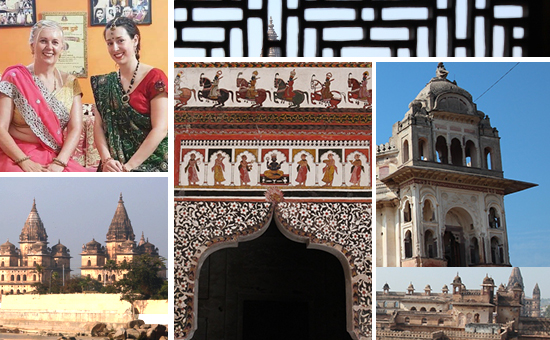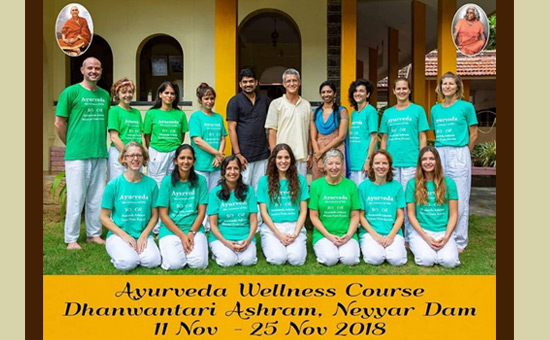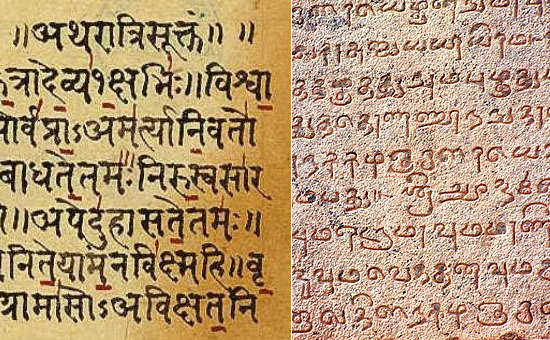- The
article highlights some of the marvels of Sanskrit (Literature, Mathematics,
Organic Farming, Ayurveda, Phonetics, and Grammar) which might inspire us to
make efforts to regain the grandeur of this magnificent language.
‘Sanskrit, as has been universally recognised by those competent to form a judgement, is one of the most magnificent, the most perfect and wonderfully sufficient literary instruments developed by the human mind; at once majestic and sweet and flexible, strong and clearly formed and full and vibrant and subtle.’ - Sri Aurobindo
In today’s so-called modern, fast paced, materialistic world, people are often disinclined towards the classical Indo-European language Sanskrit. The apathy and disrespect towards this beautiful and diverse language is widely evident when many absurdly term it as a ‘dead language’, myopically believe Sanskrit to be a language used only in temples and holy ceremonies, and consider it to be the ‘language of sadhus’.
To
read the article in PDF click on PDF. Article is courtesy Bhavan’s Journal.
Sanskrit,
the word itself means refined to the most, polished, pure and perfect.
For
Sanskrit to regain its past glory and respect, an awareness of the rich and
diverse contributions of this profound language in every aspect of human life
including religion, philosophy, ethics, mathematics, sciences, astronomy,
medicine, law, literature, agriculture, botany, poetry, music, drama,
education, erotics ,etc., would be essential.
While
the spiritual, philosophical and ritualistic contributions in Sanskrit are
generally well known, the world, and particularly we Indians need to appreciate
the diversity of Sanskrit to regain its past glory.
The
article highlights some of the marvels of Sanskrit which can inspire us to make
efforts to regain the grandeur of this magnificent language.
Literature
India was the motherland of our race and Sanskrit the mother of Europe’s languages’: Will Durant, Historian.
Most
of the culture, history and tradition of India have been written in Sanskrit.
And no matter whichever translations one reads, no other language seems to
maintain the purity and originality.
The amazing literary works by Kalidasa (famously known for his spectacular works like Meghadootham, Kumarasambhava and so on), Banabhatta (known for Kadambari, one of world’s earliest novels), Patanjali’s Yoga Sutras, spiritual scriptures like the Bhagawad Gita, Vedas, Upanishads and of course the world’s greatest epics-Mahabharata and Ramayana, were all originally written in Sanskrit.
 Orchha is a vg heritage town in M.P.
Orchha is a vg heritage town in M.P.
Nuggets of Wisdom
Subhashitas, with su meaning ‘good’, and bhashita meaning ‘spoke’ in Sanskrit, are the contributions of great Sanskrit scholars, who have succeeded in making concise and effective poems/ stanzas which have deep and life-changing meanings.
Subhashitas
were composed by ancient saints and scholars and can be dated back to 5000 BC.
Following are two subhashitani talking about the importance of the virtues such
as being enthusiasm, good habits, gratefulness and hard work. The goddess
Lakshmi (wealth) comes all by herself to stay with a person who is
enthusiastic, not lazy, knows how to work, one who is not interested in bad
habits, brave, grateful and consistent gratitude.
Tasks get accomplished by efforts and hard work, not by mere dreamin / thinking. A deer does not enter a sleeping lion’s mouth (although the lion is powerful, he has to make effort to hunt and find food).
Subhashitas
act like a teacher in formulating the sense of
morality and in character building. Teaching them to children from a
very young age can really help build their character.
The
Republic of India, most institutions of National importance including the
Supreme Court, the three Indian Armed forces (army, air force and navy), most
educational institutions in India, and several other bodies in India have adopted Sanskrit mottos, many of which are derived
from ancient Sanskrit scriptures.
This
is because Sanskrit mottos can convey powerful message in few words. For
example, (truth alone triumphs), the motto of the Republic of India is taken
from the Mundaka Upanishad, and (may
God of sea be peaceful to us) is taken from the Taittiriya Upanishad.
Mathematics
Sanskrit
not only preserves the true essence and beauty of spiritual and literary works,
but has also played a crucial role in the development of some of the famous
math formulae, computer programming and other sciences.
The
Indian mathematician Baudhayan, in one of
the sulba sutras (aphorism),
described a similar theorem as the Pythagorean Theorem,
about 1000 years before Pythagoras!
The
verse goes as follows: A rope stretched along the length of the diagonal
produces an area which the vertical and horizontal sides make together. The
diagonal and sides referred to are those of a rectangle, and the areas are
those of the squares having these line segments as their sides. Since the
diagonal of a rectangle is the hypotenuse of the right triangle formed by two
adjacent sides, the statement is seen to be equivalent to the Pythagorean
Theorem.
Interestingly,
the sulba sutra has its roots in
Vedic rituals. It contains geometry related to the construction of the
sacrificial/fire altar for Vedic rituals!
Organic Farming
We
can read Sanskrit text to gain knowledge about farming and organic pests, which
is a vital need for eco-friendly farming today.
For
example, the 184th verse of Upavana-Vinoda,
a Sanskrit treatise on arbori-horticulture
from the Sarngadhara-Paddhati Paddhati
compiled by Sarngadhara sometime in
the 14th century, states that a preparation made from the bark of Karanja, Armavadha, Arishta and Saptaparna along with urine, musta and
Vidanga has germicidal properties.
Why then do we use artificial and harmful pesticides today!
 Dhanwantari Ashram Kerala.
Dhanwantari Ashram Kerala.
Health
Ayurveda,
the knowledge of life, is considered to be the oldest healing science with a
holistic approach to health and personalised medicine comprising physical, psychological,
philosophical, ethical and spiritual health.
Isn’t it amazing that the knowledge about plastic
surgeries was written in Sanskrit by Sushruta in the 600BC, almost 150
years before Hippocrates!
In
Sushruta Samhita, his treatise on medicine written in Sanskrit and believed to be part of the Atharvaveda, Sushruta vividly describes the basic principles of plastic surgery like planning, precision, haemostatic and perfection. Particularly, Sushruta’s vivid explanation of Rhinoplasty (plastic surgery of nose) brought him the acclaim as the father of plastic surgery.
If we talk about the relevance of Sanskrit in living a healthy life in today’s world, then the ancient Charaka Samhita
describes medicinal theories on the human body and therapies for a wide range
of diseases. For example, in the modern world where people are so sleep
deprived due to stress, use of technology, etc., we can learn from the Charaka Samhita that due to irregular sleep experiences frequent yawning, body pain, laziness, headache, swelling in the eyes and dreams.
This is exactly what lead to the much later discovered saying, ‘Early to bed, early to rise, makes a man healthy, wealthy and wise’ implies!
While
we all fondly talk about the English saying, we hardly know that our ancient
doctors and vaidyas have been advocating proper sleep since time immemorial!
Sanskrit
can thus open doors for us to a healthy and holistic lifestyle.
 Sanskrit-Tamil harmony.
Sanskrit-Tamil harmony.
Ashtadhyayi
Of
great marvel is the scientific and logical structure of Sanskrit grammar which
was diligently and impeccably composed by the revered scholar Panini in his
text Ashtadhyayi (a book with eight
chapters) in around 500 BC.
Panini, in 3959 succinct sûtras (aphorisms), provides a meta language that captures the fundamentals of Sanskrit language in terms of phonology, morphology and syntax.
The
structures of these sutras have
direct parallels with computer science, including natural language processing.
These sutras are not only arrangement of letters, but in fact are structures or
a foundation through which we can build sentences.
The
sutras have an algebraic and comprehensive nature
and are known as the machine which is capable of generating infinite words and
sentences from a finite set of rules. The brevity of the sutras and the
applicability of their structure in other languages and computers science add
to their aesthetic and practical appeal.
For
example, Panini deploys a code representation called pratyahara to denote several letters. For instance, Panini uses the
pratyahara to represent vowels,
instead of directly mentioning the nine vowels makes use of the pratyahara for four letters pratyahara for all the thirty-three
consonants and so on. It is widely believed that NASA too acknowledges Sanskrit
as one of the most appropriate languages for computer programming.
Ashtadhyayi
is rightly described as the greatest monument of human intelligence by the
eminent American linguist of 20th century Leonard
Bloomfield.
Phonetics and Human Body
Sanskrit
is arguably the language most connected to human anatomy.
The
letters of Sanskrit suggest an explicit knowledge of anatomy of body. It is
basically influenced by the place of origin in the vocal system comprising teeth,
lips, upper roof, palate and the throat. The consonants are interestingly
arranged based on the anatomy of the vocal system, starting with the lowest
point, the throat, and gradually moving up to the lips.
It
is also said that speaking Sanskrit has the effect of pranayama, the practice of breath control in yoga. The sound
frequency of the utterance of anusvara, the nasal sound am (AUM), is comparable
with that generated during the practice of bhramhari
pranayama, and, the visarga sound
ah (AUM) creates an effect similar to the kapalbhati
pranayama where breath is released and stomach gets contracted.
No
wonder, speaking Sanskrit results in a very positive state of mind!
Neurologists
are trying to scientifically show the positive impact of repeated chanting and
memorisation of Sanskrit mantras, and the evidence seems encouraging.
Minimalist Living
In
these COVID days, circumstances have led us to experience and value the concept
of minimalistic.
But
the truth is that the values of living a life with lesser wants and needs has
been enshrined in Sanskrit literature. It is almost as if they could foresee
everything that was going to happen!!
Bhartrihari’s (5th century BC) Vairagya-Satakam (‘Hundred verses on renunciation’), emphasises the importance of renunciation and living a simple and contented life, which is so essential in today’s world.
Sanskrit remains highly relevant in today’s times and would continue to remain a source of inspiration for future human endeavours in varied fields. As it is said, meaning it is rare (a blessing) to have been born in India, and that too as a human being.
Hence,
as Indians, we need to be proud of Sanskrit and appreciate its immense
contributions by learning, appreciating, nurturing and spreading it.
Sanskrit, Yoga and Indian Classical Music are the three
beautiful gifts from ancient India to the world.
Today,
several countries are realising the value of Sanskrit and increasingly teaching
Sanskrit in schools and universities. It would be a shame if India is left
behind. Languages should be learnt for the joy and beauty.
As
we strive to embrace the idea of (Vasudhaiva
Kutumbakam, meaning ‘the whole world is one single family’), and sustainable living, the love and admiration for Sanskrit will help us connect better with our fellow humans and our environment. Let’s resolve to spread and regain the glory of Sanskrit.
Also
read
1.
How Sanskrit played a role in the discovery of Mendeleev's periodic table
2.
Why
Sanskrit is relevant today and tomorrow
This article was first published in the Bhavan’s Journal, 15 July 2020 issue. This article is courtesy and copyright Bhavan’s Journal, Bharatiya Vidya Bhavan, Mumbai-400007. eSamskriti has obtained permission from Bhavan’s Journal to share.